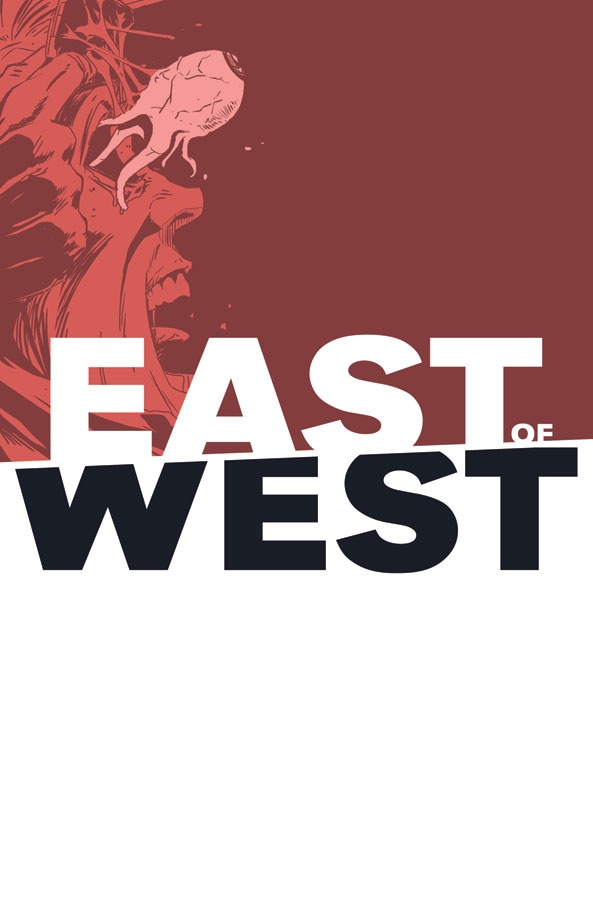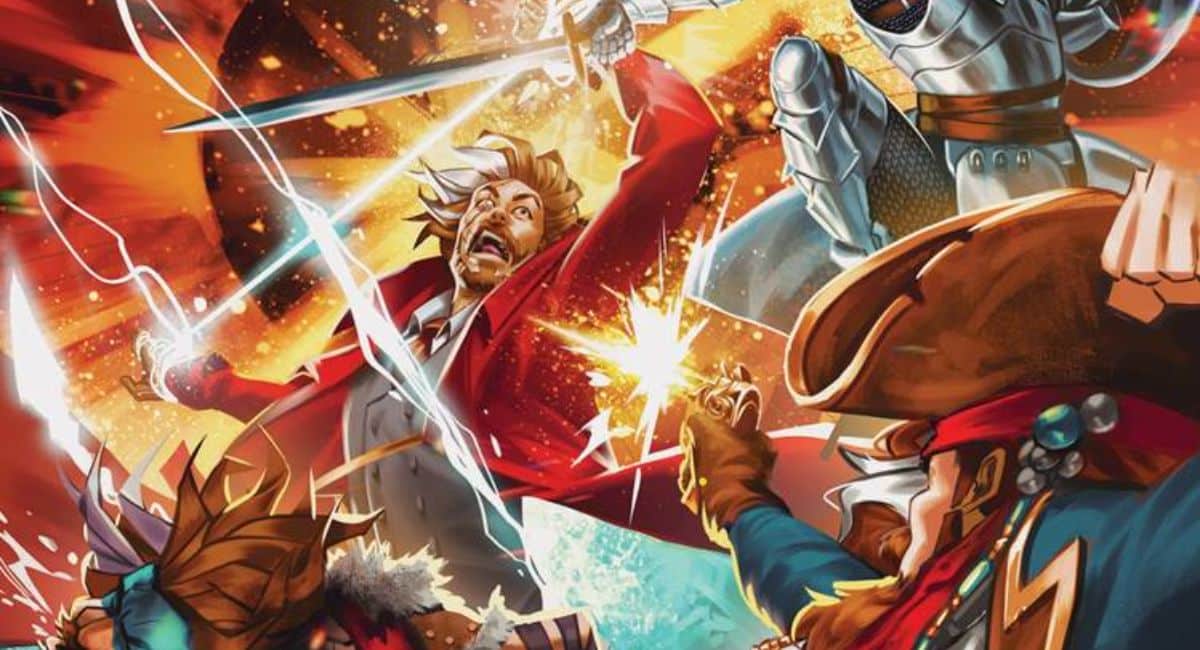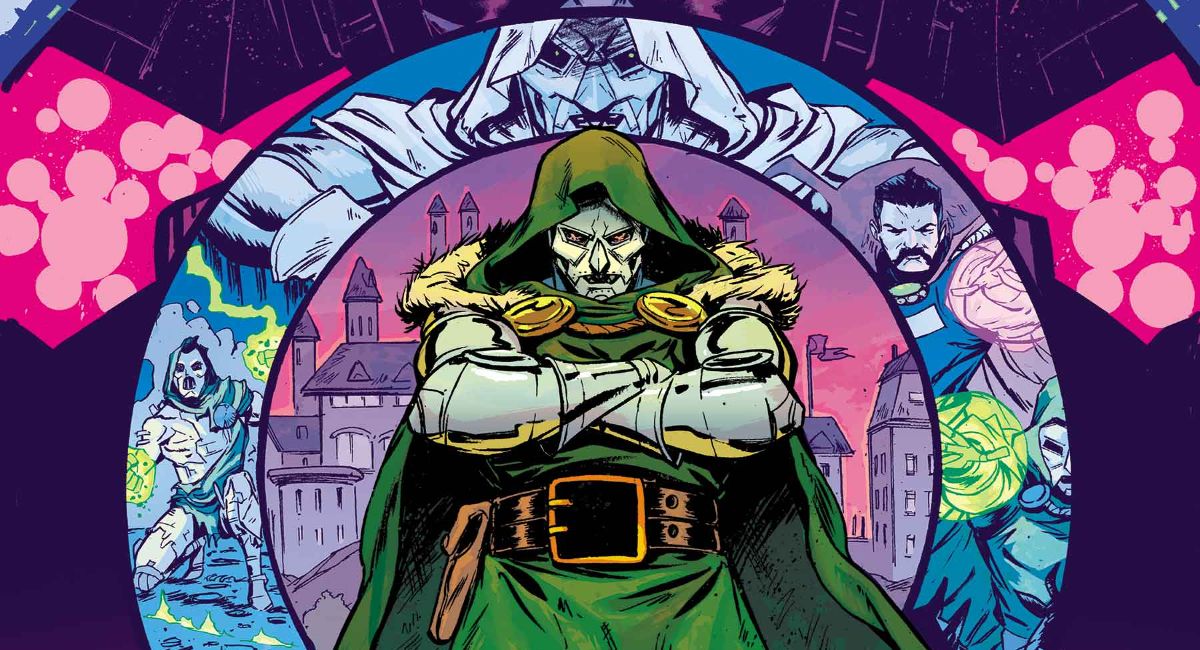By Jeffrey O. Gustafson
Jonathan Hickman and Nick Dragotta, the co-creators of the hit Image series East of West, held a panel in front of a packed audience of appreciative fans Saturday at New York Comic Con. Image Comics’ Director of Business Development Ron Richards moderated the panel, with Dragotta showing up just as things were getting started.
Richards opened up by asking about the genesis of East of West. Dragotta noted that he and Hickman met while working onFantastic Four at Marvel. Hickman said he and Dragotta got along right away, “very early on we kind of got each other, I saw there was amazing talent [in Dragotta] that wasn’t being fully utilized.” “We had a nice synergy,” Dragotta said, “And the tide was turning towards creator-owned at the time… the dream is to create and own your own work, and to work with the top writer in comics was a no-brainer.” Hickman pitched Dragotta a western series, but Dragotta wanted sci-fi, so Hickman combined the two ideas. “We messed around for about six months, figuring things out,” said Hickman.
About the story itself, Hickman said “I wanted to tell a story about the world as it is right now, but not boring. We live in a really fractured society, so we made [East of West] a real fractured society.” Amongst all the hopelessness now in the world, what better way to make things hopeful “then to make the most hopeful character in the book Death. It all kind of spiraled out of that.”
“So we began trading imagery,” Hickman said. Dragotta noted that Hickman “had a bunch of weird illustration stuff I’ve never seen, really dark stuff, like demonic.” One of Dragotta’s biggest influences which he says he comes back to is manga, both comics and illustration. And doing an Image book allows Dragotta more freedom to play with the visual pacing in ways he couldn’t do in corporate comics. “Most writers will say ‘panel one, establishing shot,’ but when you work at Image you can go and make panel one a whole splash page, so I’ll draw a building one whole page and I’ll start the second panel following page.” Dragotta uses elements like that to do deeper illustrations that reflect his diverse influences from manga to European comics to ’60s superhero. “It’s exciting, I’m learning all over again.”
Hickman will go back and forth between full scripts and outlines, depending on the scene. With some emotional or dialog heavy scenes, he’ll write a detailed script, and with large action sequences, like in issue four, he had “‘Pages 1-15, this is a battle, go with it,'” according to Dragotta. “As an artist, I don’t need art direction from Jonathan.” Hickman: “A writer’s job, in a true collaborative environment, is to inspire the artist to draw really really cool shit, that tells a really clear, really engaging story… I’ve really come full circle. I’ve written a bunch of Marvel books, and you have to turn in full scripts, and with Manhattan Projects, I stopped doing that early on and I’ve figured out comics can be a lot better if you trust the other person.” Both creators praised the contributions of colorist Frank Martin, who they will sometimes just let paint parts of the book. Dragotta, on Martin: “We are so lucky to have him, he finishes my book.”
Richards asked them about the covers, and Hickman, who primarily designs and produces the covers, said simply on his process, “they look cool. I can design all day.” On the character design, Dragotta is largely in charge of them, and the designs evolve as the book goes on.
Hickman elaborated on the unique story structure. “There’s a whole lot to why we did what we did. We’re telling a story that will meet somewhere in the middle. That’s the beauty of being able to tell the story the way that we want to. We’re really working from the middle out, both ways. What that enables us to do… you can start in the most boring part, the second act, and then down the road you get the cool cold-open and an amazing finale. Just structurally, you’re setting yourself up for an amazing double hit.” By remixing the established dynamic of story structure, he challengers himself to make better stories. “The vast majority of things I do storytelling wise, I do just because I’m bored, not because its the best way to tell the story.”
Dragotta on controlling everything about the story versus corporate comics, “There’s no rotating art teams that are going to mess up the flow… Doing your own comics is the purest form of expression, they way we’re working as a writer-artist is the next best thing.” He notes they are totally committed to the story and their level of collaboration is at an extremely high level. Dragotta doesn’t know how the story ends, though, and he likes that.
Dragotta said that overall there will be 35-50 issues, but there may be other stories in the world of East of West, though the artist did not rule out possible mini-series exploring the rich world they’ve created. Hickman did rule out anything in space. “That’s my one line [I won’t cross]. Don’t you know that the space program is dead?”
Richards then through to the audience for questions. When asked about why they went to Image, Hickman answered that the book was always going to be with the publisher. He already had a relationship with Image going back to his first published work,Nightly News. “Eric [Stephenson, Image Publisher] gave me my career. I didn’t know anyone in the industry, I cold-submitted a book to Image and he picked it up out of the mail pile and emailed me and told me he’d like to publish my book.” Richards expanded on the story, and noted that Hickman was initially considered for a production job but Stephenson fought to publish the book. Dragotta, on the Image deal: “It’s the best deal in publishing, in entertainment. It’s a scary thing to take that leap. If we doManhattan [Projects] numbers, I’m going to make more than I make at Marvel. And to come out and have the kind of hit we had, it’s incredible, it’s life changing. I really got to thank you guys for supporting creator-owned work. It makes for a better industry, it makes for better comics, and it’s the way it should be. I still read Marvel and DC, but to have this as an option is a beautiful thing, and I got to thank you guys for supporting us.”
I asked Hickman to elaborate on his design ethos, as well as the status of Feel Better Now, a comic by Hickman first announced several years ago. “I’m working on Feel Better Now, I’ve got like 40 pages of it done. Nick and I talk about this all the time, I’m looking forward to the day where I can get to draw my own stuff again, and Nick wants to draw and write his own stuff. That’s going to happen. Feel Better Now is a book that I’m writing and drawing, and its crazy dark. It’s about these psychiatrists who get bored so they play a game where they start screwing with their patients and they keep score to see who screws up their patient the most without the patient killing themselves.” He noted that as soon as he finishes up his heavy Marvel slate of writing, he’ll get back to working on Feel Better Now. About design, he kept it simple: “I open up Photoshop and pixel-fuck.”
The writer was asked about cliche in genre, and he noted that he tried as much as possible to write opposite of cliche. He wants to create a new mythology, a really cool, really inspiring story.
Just as Dragotta noted that he’s still finding his artistic voice in the work, Hickman said that he finds himself responding to Dragotta’s art, changing the story as it goes along.
When asked about possible adaptations, Dragotta more or less ruled them out, for now. The artist said he likes to make the comic so insane that a studio couldn’t afford it, (it’s working!) and that the most important thing is to make the best comic, period. And Hickman said that there is no need to rush an option or an adaptation, anyway, and that both creators, by virtue of their quality and willingness. “We don’t have to sell our books for shitty options.”
Someone asked about what fiction is currently influencing their work on East of West, and Dragotta said that The Good, The Bad, and the Ugly is one of his favorite movies, and Ridley Scott one of his favorite directors. Hickman said, “I inspire myself. I just want to do whatever the fuck I want to do.”
Finally, about the production, Dragotta said that the entire production team behind the comic is just a “small team of dedicated guys.” They are completely committed to the series and to delivering them in a timely manner. Hickman joked that the covers and advance solicitations for the issues are usually wrong because “I lie like crazy.” He never likes to give away anything about future stories, even brief synopses.
With that, Hickman, Dragotta and Richards wrapped up the panel. East of West is one of the best new series of 2013 – Dragotta’s visuals are visually arresting, and he’s producing the best stuff of his career. Hickman’s story is stunning and intricate, and his covers and production design are impeccable. The first trade paperback, collecting the first five issues, is out now for just ten bucks, with issue six now on the stands as well.







